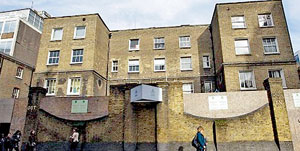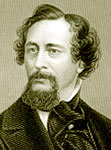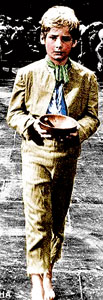The young woman at the workhouse gate was desperate. Clutching her belly, she begged to be allowed inside. She had nowhere else to go.
The workhouse - for all the stories of cruelty that went on within its walls - was her only hope. She desperately needed shelter, for she was about to give birth. But the gatekeeper was inexorable: he had his orders.
Babies were expensive. They required feeding, clothing and supervising and it would be at least six years before they could earn their keep, either in the workhouse or in factories, mills or up chimneys.
The workhouse authorities had a duty to care for mothers in such a desperate plight. They were paid by the parish to house and clothe the wretched men, women and children who came to their doors as a last resort. For few would reside in the workhouse by choice. The conditions made prison seem comfortable in comparison.
 |
| Preserved: The British government has given protected status to the former workhouse, pictured as it looks today, thought to have inspired Oliver Twist |
But the Beadle - the supervisor of the workhouse - cared less for the law than for his own pockets. He could make a small profit from able-bodied adults and children by setting them to work outside the workhouse, while he siphoned off some of the money that was supposed to feed them.
Babies, on the other hand, were not profitable. The workhouse gate clanged shut.
It was a bitterly cold day and a harsh wind was whistling up Cleveland Street, in the Georgian suburbs of North London. A crowd began to gather as the young woman went into labour on the pavement. They all knew that no newborn baby could survive long in such circumstances.
'The infant perished during this inhuman scene,' a local newspaper reported afterwards. What became of the unhappy mother is not recorded, but the incident became the talk of the neighbourhood.
Local people bemoaned the inhumanity of the workhouse, praying that they never had cause to throw themselves on its cold charity. Indeed, the story of the young woman was still doing the rounds when a young boy and his family moved into the street a few years afterwards. From his window, he watched the sorry procession of starving, destitute people make their way to the workhouse gates to beg for admittance.
He would have seen girls and boys of only six years old - just a year older than him - bundled into carts and transported like cattle, often hundreds of miles away, to work in the factories and mills of Britain's industrial heartlands, where they would be beaten as they laboured 16 hours a day in exchange for a few spoonfuls of gruel.
He would have heard the clanging of the workhouse bell, the piercing cries of insane patients confined behind its high walls, the thud of carpet-beating in the workhouse yard and the sound of inmates' hammers as they smashed granite blocks into small chunks for road-mending.
 |
| Dickens was inspired to write Oliver Twist after his own next-door experiences |
And he would have shuddered as he saw the thin pauper-coffins arrive to bury the dead in the graveyard behind the poorhouse.
He never forgot the sight, sounds and smells of that workhouse. And when he grew up he drew on those memories to reveal to Victorian Britain the inhumanity that went on under their noses in the name of progress.
The boy's name was Charles Dickens and his first major novel, Oliver Twist, was published in 1837, the same year Queen Victoria came to the throne.
It revealed the horrific abuse to which children - whose only crime was to have been born poor - were subjected.
It tells the story of the illegitimate orphan Oliver who endures a miserable time at the workhouse and during his parish apprenticeship with an undertaker, before running away and being taken in by a gang of juvenile pickpockets.
Scholars have long debated the location of Oliver Twist's workhouse. Suggestions have been made that it was in Kent or even Northamptonshire.
But I have recently discovered the link between Charles Dickens and the Cleveland Street Workhouse.
The Dickens family's first home in London, when Charles was a young boy, was on Norfolk Street. The family returned to live there again when he was a teenager. In total, Dickens lived for four years in Norfolk Street before he wrote Oliver Twist.
But you won't find it on the London A to Z. For Norfolk Street no longer exists. I previously imagined it might have been bombed to smithereens during the Blitz or developed out of existence. But recently poring closely over an old map from Dickens' time, I found it.
Norfolk Street is now the southern end of Cleveland Street. Indeed, the house in which Dickens and his family lived was only nine doors away from the workhouse.
Until just a few days ago, the building - the very place that inspired the most famous campaigning novel of all time - was scheduled to be demolished. The local MP, former Labour minister Frank Dobson, led the cries for the place, constructed in 1775, to be razed and replaced by affordable housing.
 |
| Please sir: Oliver Twist brought home the harsh realities of life in the workhouse |
As a historian, I think this would have been a grave mistake, which is why I joined a campaign to save it. To destroy not only one of the finest examples of Georgian architecture in London, but the inspiration behind one of Britain's most famous novels, would have been nothing short of barbaric. Thankfully, the Government, encouraged by English Heritage, has now given the building listed status.
It's a decision that should be applauded, for there can be no doubt that had the young Dickens not witnessed the cruelty of the workhouse at such close quarters, he could not have written so convincingly of Oliver Twist's plight.
Dickens had also experienced something of the drudgery of child labour himself. In 1823, when his father lost his job and was sent to a debtors' prison, 11-year-old Dickens was sent to work in a blacking factory, pasting labels on bottles of shoe polish.
He may well have worked alongside children from the Cleveland Street Workhouse.
He made six shillings a week, but found life as a factory boy degrading. The shame of it stayed with him all his life and he never spoke of it, even to his own wife.
But Dickens was not ill-treated by comparison with the workhouse children, sent out to work as unpaid apprentices.
Employers liked cheap child labour. And every child a parish 'sold' into employment meant one fewer to feed and clothe in the workhouse.
One of the most dangerous jobs was that of a chimney sweep. In Dickens' novel, Oliver pleads with the magistrate not to apprentice him to a sweep.
The work required very young or small boys, as their slight bodies could easily shin up the narrow, twisting chimneys. They were vulnerable to cancers caused by exposure to soot and often had accidents or suffered terrible burns. Some were choked by the soot pouring into their eyes and noses, and suffocated to death. Conditions in other workplaces were scarcely more humane. Children were often forced to live in dank, dirty spaces (Oliver sleeps under the counter of a funeral parlour).
Workhouse apprentices were often treated like animals and fed on scraps. Many died of malnutrition. One boy, Robert Blincoe — who survived to tell his tale in a memoir and is often called 'the Real Oliver Twist' — was sent from his London workhouse to work in a Nottinghamshire cotton mill. Here, children were maltreated — flogged with belts and shaken violently. Pain was used to improve productivity: their teeth were filed and their ears were put in vices to make them work harder. Some died, others were maimed for life.
In 1834 a new Poor Law was brought in, intended to discourage people from claiming relief in times of poverty and to force them to take any work they could, however low the pay. They could now only receive welfare assistance inside the workhouse. But these were to be made deliberately harsh, unpleasant places, so that people would strive to keep out of them.
Entering the workhouse was a humiliating experience. People were stripped, scrubbed and made to wear uniforms of coarse fabric to avoid infestation.
Unmarried mothers were put on a starvation diet to deter them from having any more bastard children. Families were broken up: children were separated from their parents and husbands from wives. All were forced to undertake hard labour.
But it was the children - innocents like Oliver Twist - who suffered the most. In one workhouse in Hampshire, the supervisor - a former sergeant major - was given to whipping children as young as two if they cried. Another workhouse, in Tooting, South London, saw children kept in conditions that would have shamed even the brutal prisons of that era. The supervisor, Mr Drouet, siphoned off the money given by the parish for their food and clothing.
But even though people knew how inhumane the workhouses were, they had no choice. Simply, there was nowhere else for the poor to go.
Change did eventually come to the workhouses, but not until 30 years after Oliver Twist was first published. In 1866, the medical journal The Lancet appointed a 'Sanitary Commission' to investigate the state of the London workhouses.
They asked three well-known doctors to visit several - Cleveland Street was one of them - and to report on what they found. Their reports made horrifying reading.
The public had already been outraged by the depiction of the horrors of Dickens's fictional workhouse. Now, despite the protestations of successive governments, here was hard evidence that the author had not exaggerated the horrendous conditions.
© Daily Mail, London |




